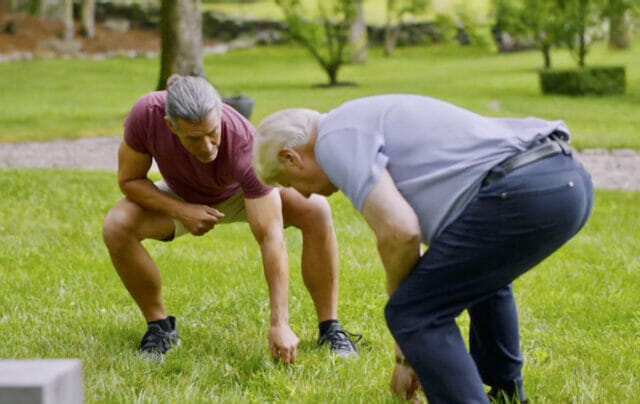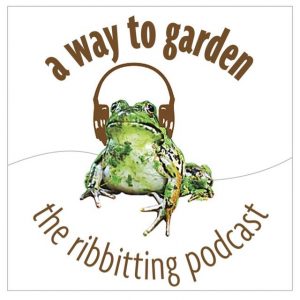YOU KNOW how it goes, especially in those tempting first spring-like days: You’re barely out of bed before you’re out in the garden having at it. And then, by day’s end, your body’s screaming that maybe, just maybe, you overdid it a little.
Well, let’s slow down and get more mindful, and take better care of our most important gardening tool: our body. Let’s get GardenFit, with help from Season 2 of the public-television program by that name, with help from its creator.
Madeline Hooper, a former public-relations executive and passionate gardener, created the GardenFit program in 2022 for public television. The format is a series of visits to private gardens nationwide, combined with lessons with the gardener behind each landscape on how to garden smarter, how to fine-tune our movements to maximize performance and minimize injury. Now Season 2 has just debuted, and she shared some of the tuneups she learned along the way.
Read along as you listen to the April 1, 2024 edition of my public-radio show and podcast using the player below. You can subscribe to all future editions on Apple Podcasts (iTunes) or Spotify (and browse my archive of podcasts here).
 staying fit as a gardener, with madeline hooper
staying fit as a gardener, with madeline hooper
Margaret Roach: Hi. Are you GardenFit, Madeline?
Madeline Hooper: I am GardenFit.
Margaret: I did what I said in the introduction. I ran out there on the first springy-like day and could barely get up the stairs by the evening [laughter].
Madeline: That’s always a tough day.
Margaret: Right. It’s like with food, sometimes our eyes are bigger than our stomachs or whatever. Tell us, just quickly, the basic conceit of GardenFit, and then also about the kinds of gardens you visited this year, because it’s kind of like a road trip and also this learning not just about gardens, but about taking care of ourselves.
Madeline: I’d love to. I think enthusiasm is a word you can associate with most gardeners. I do the same thing that you just did [laughter]. And in being so enthusiastic, I pretty much overdid it all the time. As you know, I really felt very strongly that once I actually got a solution to using my body correctly by seeing a trainer and learning things that just never came up before—how to bend, how to lift, how to get up and down from the ground—all the things that gardeners do endlessly. It’s easy to stress your body, obviously, with all these repetitive rather physical moves or tasks.
And so, I got really excited because I think all of us should not lose our enthusiasm, just lose the aches and pains that go with it [laughter]. That was fun and it was fun visiting so many people because like everyone, Margaret—and you’ve written about so many of these people—their gardens and their environment are so special and it’s just a treat to match the personality and the creativity of a person with how they actually garden. I think people will enjoy seeing that.
Margaret: Right.
Madeline: Especially in Season 2, because in Season 1, we visited people whose profession or absolute hobby, obsession, was gardening. In Season 2, we visited people who were artists in a lot of different fields, but they also garden passionately. That was a big difference.
Margaret: There’s kind of a theme within the tour around the country, of gardens in all different regions.
Madeline: Exactly. Yeah.
Margaret: I think underscoring sort of the whole show, and I watched Season 1 and I watched the start of Season 2, sharpening your pruners isn’t enough prep for a day in the garden, is it [laughter]?
Madeline: It isn’t.
Margaret: I mean, the interesting thing is, and you said it in your introduction there, we know before we play a sport, even when we’re in school, they make us warm up or when we go to the gym, they make us warm up. Everything else physical, there’s a warmup. There’s a prep. But with gardening, we just race out the door and we start wildly doing things.
Do you warm up? Is that part of becoming GardenFit?
Madeline: Well, I do warm up because I’ve been taught to do that and I have the benefit of actually making that a habit. When I walk out, literally with my most important garden tool with me, just going to get my tools, I already start warming up when I’m walking. I’ll clasp my hands behind my back, Margaret, and then it opens up my chest. As I breathe and let them slope down my back, I really feel this stretch, and I’m opening myself up not only physically, but I even think mindfully to my garden.
A lot of the things that you can do just walking to get your shovel or wheelbarrow is really exciting. I practice turning my arms inside and rotating them outside and just getting ready to prune correctly, and just different things that I feel get me even more excited about gardening, believe it or not. It’s not something that I feel these warmups or even cool downs are in the way. Now, it’s actually part of my garden routine. That’s exciting and I hope people kind of get that, that this just adds to the joy of gardening and also lessens any aftereffects.
Margaret: Right, exactly. You said make a habit and really that’s what GardenFit, I mean, that’s one of the principles, isn’t it? That we need to make these sort of new habits.
Madeline: It is. This season, I worked with a great trainer and personal trainer in Season 1, and for Season 2, I’m working with Adam Schersten, who is also a personal trainer, but his expertise is also posture and mindful ways to use the body correctly.
And so, in order to make a habit, your body has to feel like it’s in a better place. If you learn the right parts of your body to use, the right joints to use as opposed to the ones that unfortunately your body goes into sometimes—I still don’t understand why, but naturally. I mean, people bend and they bend incorrectly, meaning that if you do that a lot, your back’s going to hurt. If you do it the correct way, using the right joints and the right muscles, it’s a joy; it even strengthens your body. I think it’s just this idea of absorbing this training, if you will, to the sport of gardening. Just like what you were saying, Margaret.
Margaret: In the first couple of seasons, would you say there’s some sort of, if you had to say the things I would tell you—the high points that I would tell you other gardeners to be mindful of, careful of, to concentrate on, whatever—are there a few key tips, so to speak? You were mentioning bending and so forth. Are there a couple that over and over again at each garden that you go to in this year again of these artists who also garden, where over and again, you discussed that same thing with almost everybody, that we all need to remember [laughter]?
Madeline: Yeah. I think there are a few things. These are really Adam’s points more than mine. I learned from him a whole new perspective about how you stack your spine. A lot of people talk about posture. A lot of our guests, Frances Palmer, the ceramicist, she really wanted to talk posture. And so, this idea of putting your body in the right alignment so you remember it. Even if you have to bend, you’re not going to be able to stay in perfect posture as soon as you start getting active, but you can go back to it when you’re done with that task and it kind of rights the body again. This idea of aligning your body correctly was something that we shared with everybody, whether it was on camera or not. This is one of Adam’s key principles, body alignment.
Margaret: Stacking the spine. Being aware of that.
Madeline: Another key thing that we found a lot of gardeners asking about and, actually unfortunately, not doing correctly yet, was when people reach high or reach up, they tend to reach not only with their arm, but their shoulder comes up. That’s a real good way of hurting your shoulders. This idea of learning how the right shoulder control, about how to have your shoulders and your shoulder blades going down your back so you can just raise your arm without also hunching up. That really saves a lot of aches and pains. So that was kind of a constant theme. [Below, When reaching high keep shoulders down, creating space between your head and shoulders and relieving strain from shoulder muscles.]
Margaret: Obviously, people can watch episodes and see these principles that you’re talking about in action because it is hard, in some cases, to describe with the shoulder and not reaching with your shoulder, but reaching with your arm and the right shoulder position and so forth.
Madeline: It is. Right. Exactly.
Margaret: But that would be demonstrated…
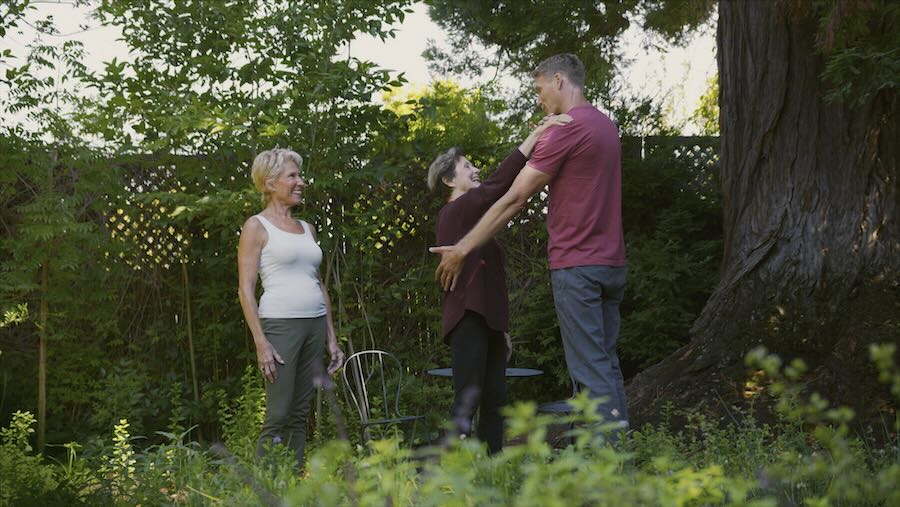
Margaret: Right. Right. I mean, one thing that I remember from Season 1, and I wonder, I’m pretty sure it would come up again because so much of gardening is one-sided, one-handed, so to speak. I was raking the other day in my ridiculous first foray outside [laughter], and I mean I still feel it a week later. Do you know what I mean? The one side that does most of the work, I’m right-handed, and the one side that sort of turns and makes most of the effort, I can feel where I was raking. And so, I remember in Season 1 you talked about being becoming ambidextrous. Now, is that something that you were talking about with people this season as well?
Madeline: Yes. I mean, I think that’s a theme throughout. To use your body correctly, you need to use both sides [laughter]. It’s just such common sense. But again, because we have a favorite hand or a side that we use all the time, that’s a habit that has to change into a better habit. I can honestly say now I never use one side of my body whether I’m digging, clipping, hauling things, pulling a tarp. I always change sides, and it has become absolutely normal for me so I don’t feel like I’m not using the right side anymore. It’s amazing how quickly your body, again, will accept a better way to do things.
Margaret: But the first time, if I’m raking in the one direction as a right-handed person, and then I go to do it to the other side because you sort of taught me about it last a couple of years ago and so forth and it’s in my mind, the first few times, I don’t want to do it. I don’t like it. I don’t feel efficient. I don’t feel as strong. Do you know what I mean? I have to push past that hesitation, right?
Madeline: Right.
Margaret: And say, “No, but this is going to be O.K. and this is going to get better.”
Madeline: I sort of liken this to the fact that we all know that the hole we’re putting the new plant in has to be bigger or deeper to a certain extent, and you push yourself. You’re tired and you want to get that plant in so badly, but you make the hole the right size. That’s how you have to feel when you’re using the new side of your body because really, I’m sure, I hope by now it’s easy for you, Margaret, or a lot easier to rake both ways.
Margaret: It does. It definitely comes in time. But the first few times you try to do it, it doesn’t feel natural and you want to go to your stronger, your dominant, side. That’s your inclination. You’ve been doing it for years.
Madeline: I think part of that, I mean, I can only speak for myself, I don’t want to assume that everybody’s like this, but when I’m doing garden tasks, I’m hurrying to get them done. I’m not really enjoying my body while I’m doing it. I think that’s part of understanding like you just started our discussion about your body being your most important tool, enjoy that. It’s fun to train the other side as opposed to, “Oh dear, I’m never going to feel good doing it this way.”
I think if you have that good attitude about, “Oh my goodness, gardening is using your body correctly,” it comes easier. There are less barriers.
Margaret: I think in Season 2, and I can’t remember if it was in Season 1 as well, but I think you even sort of get down to the level of being more mindful of how we even do something as small, in a way, small seeming, as how we grip our pruning shears. Do you know what I mean?
Madeline: Yes.
Margaret: And so, tell us about what seems like finesse, but it’s not because our hands get really exhausted after years of gardening.
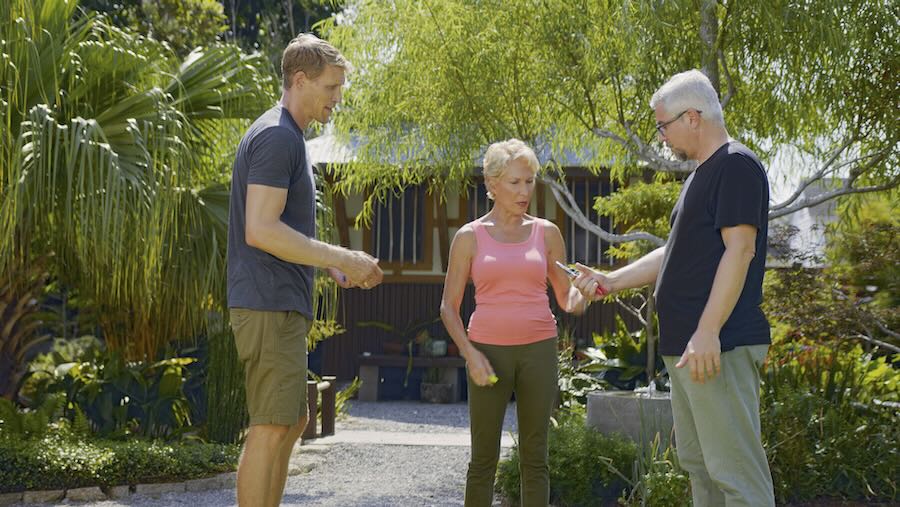
Margaret: Well, when you said it, I’m right away feeling the base of my thumb, which is where I have all the pain from all the years of letting the handle rub there.
Madeline: Right. Exactly. Just place it down a little further, really almost smack in the middle of your palm again, and just let your fingers do the actual effort of squeezing it against your palm, not against that thumb joint, which so easily gets really painful.
Margaret: Well, and that’s where a lot of people get arthritis, with anything that they do repetitively with one hand, that’s the key place for some great arthritis and so forth eventually.
Madeline: One little trick that I found was trying to learn to use my other hand, when you’re deadheading and you sort of follow the stem, if you’re deadheading a hosta flower and you just let the clippers slip down that stem to the bottom and then you clip, I found that that was such an easy guide that sometimes it was so much easier to use the other hand to actually deadhead with. Now, I deadhead almost all the time with the other hand. They’re little tricks that each of us will learn to make it again easier to be ambidextrous.
Margaret: I mean, I think that one of the other things that’s very hard on bodies of any age is all the kneeling. A lot of times we’re on ground that’s even on hardscape. You know what I mean? People are kneeling and you’re trying to get to something and you’re kneeling and you’re reaching across a bed and whatever. And so, any advice there for kneeling? I mean, because it’s-
Madeline: Well, again, I have to just sort of repeat what Adam has said to me: Use a knee pad. A knee pad that’s attached to your clothes, that you literally put on your knees, or one that you use on the ground. Now, I have done that, because it is a lot of pressure, your whole body weight, just think about that when you’re on your knees. I think it’s important to use a knee pad and do a lot of weeding or groundwork using a knee pad.
We also still love this squat position, which we call the armchair in Season 1 [below], which is really… I do a lot of work in pruning and working close to the ground, like weeding, in that position, too, because I feel it strengthens my body. I like the feel of that now.
Margaret: Right. The armchair position is an improved version of sort of crouching, of getting way down there. But it’s an improved, a smarter version.
Madeline: Right. Well, and it’s because it allows you to put the weight of your body by putting your hand on one leg. Then you have one hand free to weed with. If you don’t have to use both hands for the weeds that you’re trying to get up, it’s really a way of cutting down on so much stress on your body. It’s great.
Margaret: Right. I was curious about, you said you went to all these artists’ gardens, and you mentioned Frances Palmer, the ceramic artist, and so forth. Any others that you just want to, just a couple of examples of another-
Madeline: Well, we went to this artist, Jose Alvarez, and Jose started a 2-acre tropical garden in Fort Lauderdale by himself. Now, the plants are so gigantic, it’s a whole jungle environment. Because he’s a visual artist, he does absolutely beautiful paintings. They’re very abstract, but they’re very colorful and they almost look like his garden to me now, even though of course nothing.
I mean, it’s interesting, Margaret, how these artists, whether they were musicians, or we went to visit Alice Waters, who certainly started the whole farm-to-table movement and is so concerned about what we grow and that we consume food that’s close to where we live. It has so many wonderful, important things to teach people about health and gardens. I feel all of them are so inspired by nature. They do take the time to look and listen. I don’t think they could live a day without being in their garden.
That was really impressive because these people are busy and have huge lives, and a lot of them traveled. We visited this woman, Cynthia Meyers, who is the flautist for the Boston Symphony Orchestra. When they’re in session, she can’t even be home in her garden, which is pollinating plants. I mean, she’s the person, I don’t know if I mentioned this to you, who literally has gardens full of what I would call weeds, because she just loves letting whatever seeds are in the soil around her home grow. She just cultivates them in such an interesting way.
I feel like I learned a lot from each guest gardener this season about why they made the choices they did, and what’s in their garden. There’s a bigger variety of types of gardens, I think, too.
Margaret: I was going to ask, you were talking about how important it’s been for you to learn about warming up, but do you have an Achilles heel, ha ha? Was there something that when you started doing this show that you hoped most to find a solution for or mitigate in some way? Did you have a particular thing? Some people it’s knees, or some people it’s backache or whatever.
Madeline: Yes [laughter]. Definitely. My upper shoulder area on my back to my neck hurt me every morning. I would get up every morning and really have pain or, unfortunately, a headache. That part of me just seems to be where all the tension goes. And then, on top of that, doing all the activities that I was doing. If somebody had taken a picture of me, Margaret, how I used to garden, I would look like I was creating stress to my body [laughter] or literally it would be painful.
Margaret: Become a gardener, get more stressed [laughter].
Madeline: Yes. I think we do that for other reasons. I think, again, just learning the correct form, the way to use my body. When I bend over, or I think one of my key things is if I’m deadheading again, I put one foot in the direction I’m bending so that I can keep my back straight and not hunched up and just use my hip joints. I’m bending from my hip, not from my back. I don’t have to hunch over anymore. The relief of that, again, changes the joy and of course takes away the pain.
Margaret: That probably took a while though to retrain your brain to say, “O.K., wait a minute. No, no. Point the foot. Follow the hip.”
Madeline: I think that, again, watching the show or even our socials, there’s repetitive visuals of that. I don’t do it exactly right all the time. I probably don’t even do it exactly right half the time, but now I’m aware when I’m not in the right position and I know how to correct it. That’s sort of part of the journey of getting GardenFit.
I mean, we’re all human. I’m going to bend over and pick up something that I dropped on the floor. I’m not going into the armchair all the time, although I find that I laugh at myself, because I find that I’m overdoing certain good form things just to do simple tasks [laughter].
Margaret: Taking it to an extreme, huh?
Madeline: Yes, definitely.
Margaret: From this season especially, were there other things that you saw that were like a light bulb for the most people that really you kept hearing over and again, and people really appreciated? Any other-

Margaret: Not the elbows flaring out when we’re using a big cutting tool like a lopper or shears.
Madeline: Right. Exactly. Make sure that they’re turning in. And then, you can adjust again, your hands, your wrists, to turn any way you want to make it comfortable. But that was a big aha, I think. I think it was a big aha for people about how to get up and down from the ground, because in a lot cases, Adam showed the right alignment so when you are getting up, if you’re on two knees, or if you’re just working on even one knee and the other leg is up in front, to make sure your body’s aligned in a certain way where that hip isn’t out or in a position where if you got up when you’re not aligned, you really would be straining your hips and your back.
I think there’s a lot of, again, visual understanding of what your body can and should look like in the show. And then, people can easily follow it. Everything’s easy. Nothing requires exercises or exercise equipment. It’s just stuff we can do in the garden.
Margaret: Right. I love the idea though, of even if each of us listening does nothing else this year but what you were describing, and it was making a mental image for me, on our way out to the garden before we get to the garage to get our shovel or whatever, just stretching those arms and clasping them behind us and lifting them and lowering them and maybe rotating our shoulders. You know what I mean? Just if nothing else, if we just warm up for three minutes, I think that’s-
Madeline: Yep, it would make such a difference. Exciting.
Margaret: And so the new season is underway, huh?
Madeline: It is. Every week now, there will be a new episode. You can see it on pbs.org/GardenFit or look at your local TV listings. I’m really excited. It’s kind of out there [laughter].
Margaret: Good for you. The other thing, we minimized this, but it’s no small matter: incredible gardens. I mean, the pictures I saw that they shared with me. I mean, if you just want to watch it for the garden touring is great, too.
Madeline: I hope so.
Margaret: Thank you so much.
watch ‘gardenfit’
prefer the podcast version of the show?
MY WEEKLY public-radio show, rated a “top-5 garden podcast” by “The Guardian” newspaper in the UK, began its 15th year in March 2024. It’s produced at Robin Hood Radio, the smallest NPR station in the nation. Listen locally in the Hudson Valley (NY)-Berkshires (MA)-Litchfield Hills (CT) Mondays at 8:30 AM Eastern, rerun at 8:30 Saturdays. Or play the April 1, 2024 show using the player near the top of this transcript. You can subscribe to all future editions on iTunes/Apple Podcasts or Spotify (and browse my archive of podcasts here).


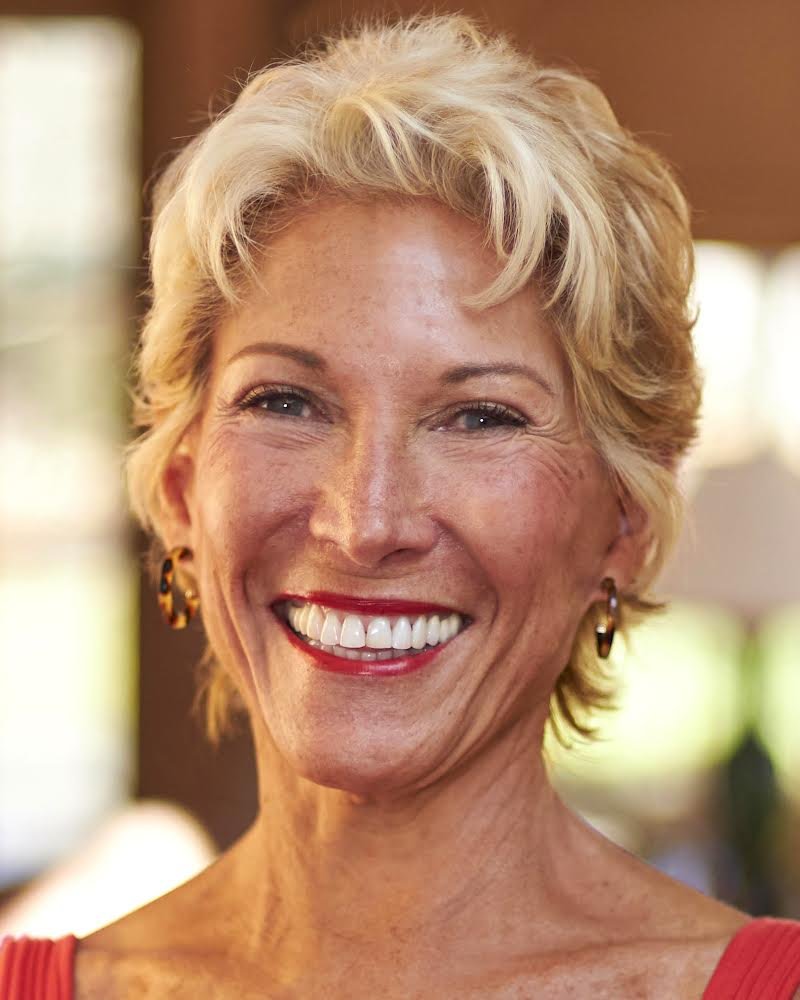 staying fit as a gardener, with madeline hooper
staying fit as a gardener, with madeline hooper